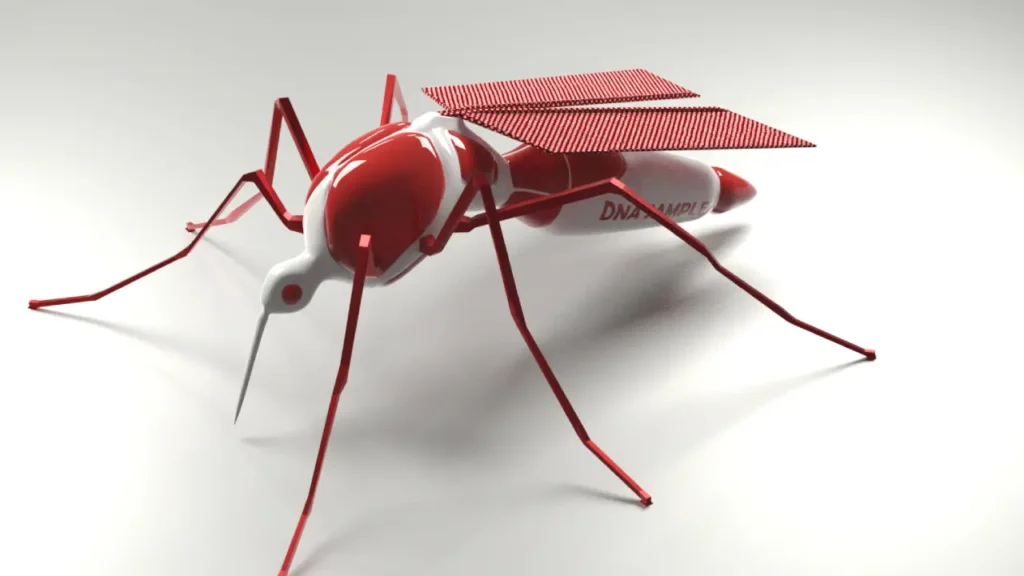In a groundbreaking development, Chinese military researchers have unveiled a mosquito-sized microdrone, setting a new benchmark in the race for ultra-miniature surveillance technology. Developed by a robotics team at the National University of Defense Technology (NUDT) in Hunan province, this bionic insect-sized drone is designed for covert military operations, with capabilities that could transform modern warfare.
What Is China’s Mosquito Drone?
The microdrone, showcased on CCTV 7, China Central Television’s military channel, was presented by NUDT student Liang Hexiang. Holding the tiny robot between his fingers, Liang described it as a “mosquito-like robot” built for information reconnaissance and special missions on the battlefield.
Approximately 1.3 centimeters in length, the drone is small enough to resemble a real mosquito. It features two leaf-shaped wings and three ultra-thin legs. Designed to be controlled via smartphone, this tiny drone is virtually invisible during flight—making it an ideal tool for surveillance, spying, and reconnaissance missions.

Why Microdrones Matter: Not Just Science Fiction Anymore
Microdrones like China’s latest development fall under the category of unmanned aerial vehicles (UAVs) weighing less than 250 grams. Their compact size, lightweight build, and maneuverability make them perfect for military and intelligence operations in difficult or high-risk environments, especially in urban warfare, tactical combat, and intelligence gathering.
These micro-UAVs are hard to detect, can enter confined or guarded areas, and may be equipped with cameras, sensors, or even chemical payloads. That makes them uniquely suited for operations where larger drones or manned units would be detected instantly.
How Does the Mosquito Drone Work?
While the technical specifications of China’s mosquito drone—like flight duration, control range, or onboard sensors—haven’t been publicly disclosed, its design and application suggest it could serve as:
- A surveillance tool for ground troops
- A reconnaissance agent in hard-to-reach or dangerous areas
- A covert device for intelligence gathering in enemy territories
- Possibly, a delivery system for lightweight toxic or tracking payloads
The microdrone’s resemblance to a mosquito isn’t just for show—it helps the drone blend in with its environment, mimicking biological movement similar to nature. The insect-inspired design follows the same biomimicry principles seen in Harvard’s RoboBee, an American-developed insect drone project.
The Bigger Picture: The Global Microdrone Arms Race
This innovation from China signals an escalation in the global race for micro-scale warfare technology. Nations around the world have been exploring microdrones for years. For example:
- Harvard’s RoboBee is a lab prototype using artificial muscles, still limited to controlled settings.
- Black Hornet 4, used by Western militaries, is a palm-sized reconnaissance drone with thermal imaging and night vision—ideal for real-time battlefield monitoring.
But China’s mosquito drone brings something new: stealth combined with scale.
In comparison to other microdrones, the flapping-wing technology offers quieter motion and the ability to hover or fly undetected, especially in cluttered or noisy environments.
Potential Ethical and Strategic Concerns
As impressive as this technology is, it raises significant ethical and geopolitical concerns:
- Surveillance Abuse: Could such drones be used to spy on civilians or political adversaries?
- Weaponization Risk: Could these drones deliver toxins or other harmful agents?
- Escalation of Espionage: With microdrones getting harder to detect, national security threats multiply.
The miniaturization of drones blurs the line between innovation and invasion. As these mosquito drones evolve from lab prototypes to field-ready machines, international watchdogs and defense analysts are closely monitoring their progress.
What’s Next for Mosquito-Sized Drones?
NUDT’s development is more than a technological breakthrough—it’s a strategic message to global powers: China is investing heavily in next-gen warfare tools. With AI-controlled drone swarms, autonomous UAVs, and now micro bionic drones, China is positioning itself as a leader in autonomous military intelligence.
The next steps will likely involve:
- Enhancing battery life and range
- Adding real-time video transmission
- Integrating AI for autonomous decision-making
- Mass deployment for swarm tactics
Final Thoughts
The unveiling of China’s mosquito-sized microdrone is a chilling yet fascinating preview of the future of warfare. As micro-UAV technology matures, the battlefield will no longer be dominated by tanks or missiles alone—but also by silent, near-invisible machines capable of infiltrating without warning.
This tiny bionic flyer could be the start of something huge—and the world should be paying attention.







